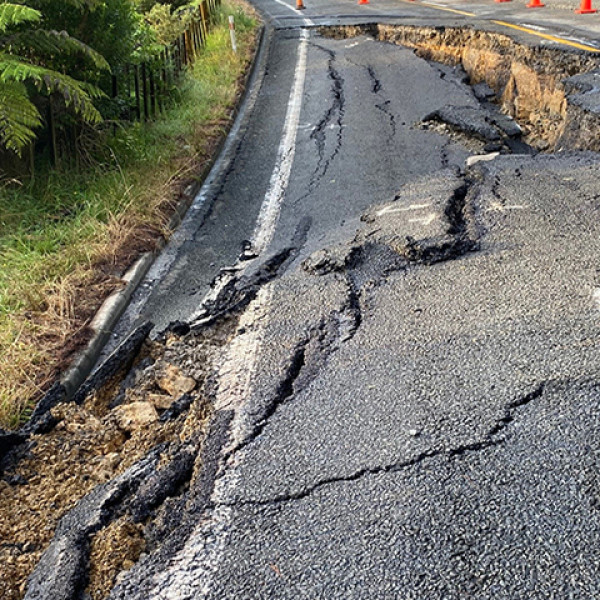
SH23 between Whatawhata and Raglan was damaged in the January 2023 weather events and was closed to all traffic on 1 February. It reopened on 4 March using a temporary diversion road built on private land; traffic returned to the repaired highway in mid-May, with the project completed in early June.
State Highway 23 between Whatawhata and Raglan is a crucial link between Raglan and Hamilton. It was closed in February 2023 following a serious underslip on the section known as the Raglan Deviation.
A lengthy detour via Ngāruawāhia and Waingaro was required during the closure.
Waka Kotahi constructed a temporary diversion road around the underslip site through private property, which opened on 4 March.
The diversion plan started to take shape on Friday 3 February, and after the Waka Kotahi team met with landowners, fence and tree removal began ahead of earthworks.
Waka Kotahi is very grateful to landowners for their generous co-operation, and to Vodafone NZ for enabling us to work within close proximity of the fibre optic cable that runs through the site of the slump.
The temporary diversion road allowed the time needed to investigate and plan the long-term restoration of SH23. A number of options were considered, but as the ground conditions under the slope were worse than expected, the best solution was to build a geosynthetic-reinforced retaining wall with concrete piles drilled 12m deep into the hillside to support it. This is a robust and cost-effective solution, providing resilience for the future on this route.
The retaining wall was completed in early May, with traffic returned to the original highway in the middle of that month. Working around the wet weather, paving, asphalting, lane markings and the installation of guardrail completed the project in early June.
Monday 30 January: Cracking on the section of SH23 known as the Raglan Deviation (‘the Raglan Divvy’) to the west of Glentui Lane was identified following the major storm event that hit much of the North Island. One lane was affected, and the road was reduced to one lane under stop/go traffic management. Metal was placed on the shoulder of the road to increase the road width, moving traffic further away from the edge of the cracking, and an asphalt bund was created to try and stop water running into the cracks.
Tuesday 31 January: The site was monitored throughout the day, and the cracking widened and worsened, along with slumping of the road by approx. 200mm.
Wednesday 1 February: The decision was made to close the road overnight from 7pm to 7am until an urgent assessment was made. Early geotechnic work indicated the site was saturated, and the concrete kerb and channel had fully cracked through, letting water into the underslip.
Thursday 2 February: The road was closed to all traffic, with geotechnical engineers carrying out drilling and core penetration tests to investigate the severity of the situation and ongoing risk.
Early-February: With no chance of utilising the existing roadway, work began to build a diversion around the underslip.
Saturday 4 March: Waka Kotahi opened a two-lane temporary diversion road on private property that skirts the underslip. The diversion road allowed the time to investigate and plan the long-term restoration.
6-13 March: Underslip stabilised with soil nails, while investigation and planning continued.
Tuesday 14 March: Solution decided: a geosynthetic-reinforced retaining wall with Continuous Flight Auger concrete piles.
Thursday 16 March: Rig established on site.
Friday 17 March: Concrete drilling began.
Friday 24 March: Construction of retaining wall began.
Early May: Retaining wall completed.
Mid May: Traffic returned to the original highway.
29 May: Paving and asphalting completed.
Early June: Lane markings and guardrail installation completed.